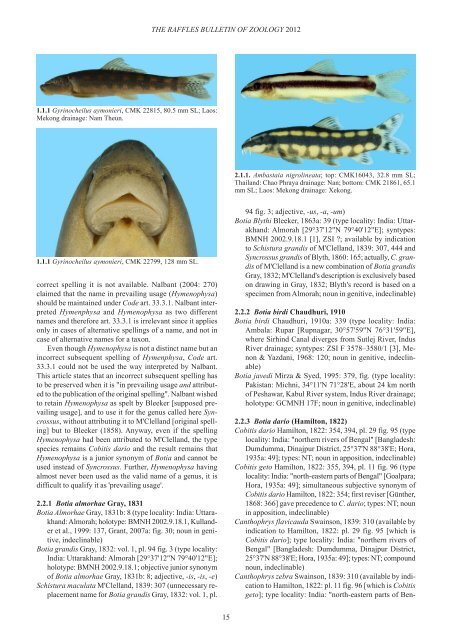Conspectus cobitidum - Raffles Museum of Biodiversity Research
Conspectus cobitidum - Raffles Museum of Biodiversity Research
Conspectus cobitidum - Raffles Museum of Biodiversity Research
You also want an ePaper? Increase the reach of your titles
YUMPU automatically turns print PDFs into web optimized ePapers that Google loves.
1.1.1 Gyrinocheilus aymonieri, CMK 22815, 80.5 mm SL; Laos:<br />
Mekong drainage: Nam Theun.<br />
1.1.1 Gyrinocheilus aymonieri, CMK 22799, 128 mm SL.<br />
correct spelling it is not available. Nalbant (2004: 270)<br />
claimed that the name in prevailing usage (Hymenophysa)<br />
should be maintained under Code art. 33.3.1. Nalbant interpreted<br />
Hymenphysa and Hymenophysa as two different<br />
names and therefore art. 33.3.1 is irrelevant since it applies<br />
only in cases <strong>of</strong> alternative spellings <strong>of</strong> a name, and not in<br />
case <strong>of</strong> alternative names for a taxon.<br />
Even though Hymenophysa is not a distinct name but an<br />
incorrect subsequent spelling <strong>of</strong> Hymenphysa, Code art.<br />
33.3.1 could not be used the way interpreted by Nalbant.<br />
This article states that an incorrect subsequent spelling has<br />
to be preserved when it is "in prevailing usage and attributed<br />
to the publication <strong>of</strong> the original spelling". Nalbant wished<br />
to retain Hymenophysa as spelt by Bleeker [supposed prevailing<br />
usage], and to use it for the genus called here Syncrossus,<br />
without attributing it to M'Clelland [original spelling]<br />
but to Bleeker (1858). Anyway, even if the spelling<br />
Hymenophysa had been attributed to M'Clelland, the type<br />
species remains Cobitis dario and the result remains that<br />
Hymenophysa is a junior synonym <strong>of</strong> Botia and cannot be<br />
used instead <strong>of</strong> Syncrossus. Further, Hymenophysa having<br />
almost never been used as the valid name <strong>of</strong> a genus, it is<br />
difficult to qualify it as 'prevailing usage'.<br />
2.2.1 Botia almorhae Gray, 1831<br />
Botia Almorhae Gray, 1831b: 8 (type locality: India: Uttarakhand:<br />
Almorah; holotype: BMNH 2002.9.18.1, Kullander<br />
et al., 1999: 137, Grant, 2007a: fig. 30; noun in genitive,<br />
indeclinable)<br />
Botia grandis Gray, 1832: vol. 1, pl. 94 fig. 3 (type locality:<br />
India: Uttarakhand: Almorah [29°37'12"N 79°40'12"E];<br />
holotype: BMNH 2002.9.18.1; objective junior synonym<br />
<strong>of</strong> Botia almorhae Gray, 1831b: 8; adjective, -is, -is, -e)<br />
Schistura maculata M'Clelland, 1839: 307 (unnecessary replacement<br />
name for Botia grandis Gray, 1832: vol. 1, pl.<br />
THE RAFFLES BULLETIN OF ZOOLOGY 2012<br />
15<br />
2.1.1. Ambastaia nigrolineata; top: CMK16043, 32.8 mm SL;<br />
Thailand: Chao Phraya drainage: Nan; bottom: CMK 21861, 65.1<br />
mm SL; Laos: Mekong drainage: Xekong.<br />
94 fig. 3; adjective, -us, -a, -um)<br />
Botia Blythi Bleeker, 1863a: 39 (type locality: India: Uttarakhand:<br />
Almorah [29°37'12"N 79°40'12"E]; syntypes:<br />
BMNH 2002.9.18.1 [1], ZSI ?; available by indication<br />
to Schistura grandis <strong>of</strong> M'Clelland, 1839: 307, 444 and<br />
Syncrossus grandis <strong>of</strong> Blyth, 1860: 165; actually, C. grandis<br />
<strong>of</strong> M'Clelland is a new combination <strong>of</strong> Botia grandis<br />
Gray, 1832; M'Clelland's description is exclusively based<br />
on drawing in Gray, 1832; Blyth's record is based on a<br />
specimen from Almorah; noun in genitive, indeclinable)<br />
2.2.2 Botia birdi Chaudhuri, 1910<br />
Botia birdi Chaudhuri, 1910a: 339 (type locality: India:<br />
Ambala: Rupar [Rupnagar, 30°57'59"N 76°31'59"E],<br />
where Sirhind Canal diverges from Sutlej River, Indus<br />
River drainage; syntypes: ZSI F 3578–3580/1 [3], Menon<br />
& Yazdani, 1968: 120; noun in genitive, indeclinable)<br />
Botia javedi Mirza & Syed, 1995: 379, fig. (type locality:<br />
Pakistan: Michni, 34°11'N 71°28'E, about 24 km north<br />
<strong>of</strong> Peshawar, Kabul River system, Indus River drainage;<br />
holotype: GCMNH 17F; noun in genitive, indeclinable)<br />
2.2.3 Botia dario (Hamilton, 1822)<br />
Cobitis dario Hamilton, 1822: 354, 394, pl. 29 fig. 95 (type<br />
locality: India: "northern rivers <strong>of</strong> Bengal" [Bangladesh:<br />
Dumdumma, Dinajpur District, 25°37'N 88°38'E; Hora,<br />
1935a: 49]; types: NT; noun in apposition, indeclinable)<br />
Cobitis geto Hamilton, 1822: 355, 394, pl. 11 fig. 96 (type<br />
locality: India: "north-eastern parts <strong>of</strong> Bengal" [Goalpara;<br />
Hora, 1935a: 49]; simultaneous subjective synonym <strong>of</strong><br />
Cobitis dario Hamilton, 1822: 354; first reviser [Günther,<br />
1868: 366] gave precedence to C. dario; types: NT; noun<br />
in apposition, indeclinable)<br />
Canthophrys flavicauda Swainson, 1839: 310 (available by<br />
indication to Hamilton, 1822: pl. 29 fig. 95 [which is<br />
Cobitis dario]; type locality: India: "northern rivers <strong>of</strong><br />
Bengal" [Bangladesh: Dumdumma, Dinajpur District,<br />
25°37'N 88°38'E; Hora, 1935a: 49]; types: NT; compound<br />
noun, indeclinable)<br />
Canthophrys zebra Swainson, 1839: 310 (available by indication<br />
to Hamilton, 1822: pl. 11 fig. 96 [which is Cobitis<br />
geto]; type locality: India: "north-eastern parts <strong>of</strong> Ben-

















